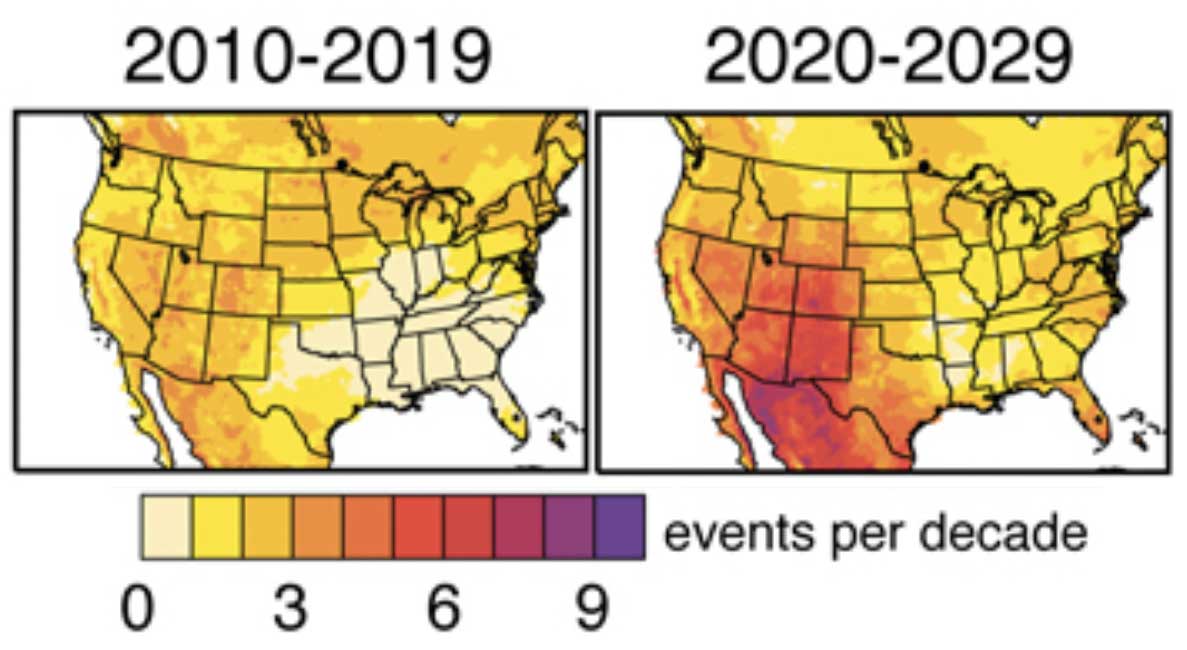Climate Change Temperature Forecasts
2010 - 2020 Decade Temperatures
See additional forecasts of global warming heat waves.
2014 | Climate Change Temperatures
2014. Britain’s Met Office projects 2014 temperature likely to be 0.3 degrees Celsius warmer than 2004.
“Here is the climate forecast for the next decade [2007-2014]; although
global warming will be held in check for a few years, it will come
roaring back to send the mercury rising before 2014. This is the
prediction of the first computer model of the global climate designed
to make forecasts over a timescale of around a decade, developed by
scientists at the Met Office. The new model developed at the Met's Hadley Centre in Exeter, and described in the journal Science,
predicts that warming will slow during the next few years but then
speed up again, and that at least half of the years after 2009 will be
warmer than 1998, the warmest year on record.
___________________________________________________
Between 2010 and 2019 [9 years], temperatures equaling the hottest season on record from 1951 to 1999 [a 48 year period] could occur four times over much of the U.S. (6)
___________________________________________________
2020. Temperatures on Earth projected by 2020 to be at the hottest levels in 150,000 years. “Astronomer and author Carl Sagan says a closer look at Venus
could help inspire Earth's residents to break their dependence on
fossil fuels. Speaking to more than 1,000 people Thursday [September
13, 1990] at the College of Southern Idaho,
Sagan said Venus is an incredibly hot, barren planet because of the
intense greenhouse effect there. And that should be a lesson to people
on Earth, which faces a worsening greenhouse effect with the continued
use of fuels like oil and coal, which produce carbon dioxide that traps
heat in the atmosphere.
‘Every lump of coal burned, every
gallon of gas, puts carbon dioxide in the air,’ Sagan said. ‘Doubters
of the greenhouse effect need look no farther than Venus, which has
lots of carbon dioxide and surface temperatures of 900 degrees
Fahrenheit.’ If the buildup of carbon dioxide continues in the Earth's
atmosphere, he said, temperatures on Earth are projected to be at their
hottest level in 150,000 years by the year 2020.” (Carl Sagan quoted in
“Sagan Says Fossil-Fuel Use May Turn Earth Into A Venus,” The Deseret News, Salt Lake City, Utah, September 16, 1990, p. B4) See Carl Sagan's published works, documentaries and video of Carl Sagan and Stephen Hawking on climate disruption and global warming.
___________________________________________________
Venus is an incredibly hot, barren
planet because of the intense greenhouse effect there. And that should
be a lesson to people on Earth, which faces a worsening greenhouse
effect with the continued use of fuels like oil and coal, which produce
carbon dioxide that traps heat in the atmosphere. (1)
Astronomer, Astrophysicist
Pulitzer Prize winner
Twin Falls, Idaho
___________________________________________________
The study comes on the heels of a recent NASA report that concluded that the previous decade, January 2000 to December 2009, was the warmest on record. . . . ‘This was an unprecedented experiment,’ Diffenbaugh said. ‘With the high-resolution [RegCM3] climate model, we can analyze geographic quadrants that are only 15.5 miles [25 kilometers] to a side. No one has ever completed this kind of climate analysis at such a high resolution.’ The results were surprising.
According to the climate models, an intense heat wave – equal to the longest on record from 1951 to 1999 [a period of 48 years] – is likely to occur as many as five times between 2020 and 2029 [a period of 9 years] over areas of the western and central United States. . . .
Besides harming human health and agriculture, these hot, dry conditions could lead to more droughts and wildfires in the near future, he said. And many of these climate change impacts could occur within the next two decades [2010-2030] -- years before the planet is likely to reach the 2-degree C threshold targeted by some governments and climate experts, [Diffenbaugh] added.” (Mark Shwartz, communications manager, Woods Institute for the Environment at Stanford University, “Heat waves and extremely high temperatures could be commonplace in the U.S. by 2039, Stanford study finds,” Stanford Report, July 8, 2010 citing findings in Diffenbaugh, N., and M. Ashfaq. Intensification of hot extremes in the United States. Geophys. Res. Lett., (in press) DOI: 10.1029/2010GL043888, published August 6, 2010)
Number of Extremely Hot Seasons Per Decade 2020-2029
Projected heat for U.S. -- Source: Diffenbaugh and Ashfaq, Aug., 6, 2010
Lorem Ipsum
(1) Carl Sagan quoted in “Sagan Says Fossil-Fuel Use May Turn Earth Into A Venus,” The Deseret News, Salt Lake City, Utah, September 16, 1990, p. B4
________________________________________________
